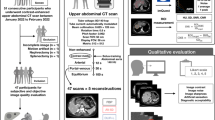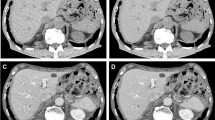Abstract
Objectives
To investigate the image quality and perception of a sinogram-based deep learning image reconstruction (DLIR) algorithm for single-energy abdominal CT compared to standard-of-care strength of ASIR-V.
Methods
In this retrospective study, 50 patients (62% F; 56.74 ± 17.05 years) underwent portal venous phase. Four reconstructions (ASIR-V at 40%, and DLIR at three strengths: low (DLIR-L), medium (DLIR-M), and high (DLIR-H)) were generated. Qualitative and quantitative image quality analysis was performed on the 200 image datasets. Qualitative scores were obtained for image noise, contrast, small structure visibility, sharpness, and artifact by three blinded radiologists on a 5-point scale (1, excellent; 5, very poor). Radiologists also indicated image preference on a 3-point scale (1, most preferred; 3, least preferred). Quantitative assessment was performed by measuring image noise and contrast-to-noise ratio (CNR).
Results
DLIR had better image quality scores compared to ASIR-V. Scores on DLIR-H for noise (1.40 ± 0.53), contrast (1.41 ± 0.55), small structure visibility (1.51 ± 0.61), and sharpness (1.60 ± 0.54) were the best (p < 0.05) followed by DLIR-M (1.85 ± 0.52, 1.66 ± 0.57, 1.69 ± 0.59, 1.68 ± 0.46), DLIR-L (2.29 ± 0.58, 1.96 ± 0.61, 1.90 ± 0.65, 1.86 ± 0.46), and ASIR-V (2.86 ± 0.67, 2.55 ± 0.58, 2.34 ± 0.66, 2.01 ± 0.36). Ratings for artifacts were similar for all reconstructions (p > 0.05). DLIRs did not influence subjective textural perceptions and were preferred over ASIR-V from the beginning. All DLIRs had a higher CNR (26.38–102.30%) and lower noise (20.64–48.77%) than ASIR-V. DLIR-H had the best objective scores.
Conclusion
Sinogram-based deep learning image reconstructions were preferred over iterative reconstruction subjectively and objectively due to improved image quality and lower noise, even in large patients. Use in clinical routine may allow for radiation dose reduction.
Key Points
• Deep learning image reconstructions (DLIRs) have a higher contrast-to-noise ratio compared to medium-strength hybrid iterative reconstruction techniques.
• DLIR may be advantageous in patients with large body habitus due to a lower image noise.
• DLIR can enable further optimization of radiation doses used in abdominal CT.






Similar content being viewed by others
Abbreviations
- ASIR-V:
-
Adaptive statistical iterative reconstruction-V
- CNR:
-
Contrast-to-noise ratio
- CT:
-
Computed tomography
- DLIR:
-
Deep learning image reconstruction
- FBP:
-
Filtered back projection
References
OECD (2020) Computed tomography (CT) exams (indicator). https://doi.org/10.1787/3c994537-en. Accessed on 17 June 2020
Hong JY, Han K, Jung JH, Kim JS (2019) Association of exposure to diagnostic low-dose ionizing radiation with risk of cancer among youths in South Korea. JAMA Netw Open 2(9):e1910584
Sodickson A, Baeyens PF, Andriole KP et al (2009) Recurrent CT, cumulative radiation exposure, and associated radiation-induced cancer risks from CT of adults. Radiology 251(1):175–184
Lurz M, Lell MM, Wuest W et al (2015) Automated tube voltage selection in thoracoabdominal computed tomography at high pitch using a third-generation dual-source scanner: Image quality and radiation dose performance. Invest Radiol 50(5):352–360
Mozaffary A, Trabzonlu TA, Kim D, Yaghmai V (2019) Comparison of tin filter-based spectral shaping CT and low-dose protocol for detection of urinary calculi. AJR Am J Roentgenol 212(4):808–814
Parakh A, Kortesniemi M, Schindera ST (2016) CT radiation dose management: A comprehensive optimization process for improving patient safety. Radiology 280(3):663–673
den Harder AM, Willemink MJ, van Doormaal PJ et al (2018) Radiation dose reduction for CT assessment of urolithiasis using iterative reconstruction: A prospective intra-individual study. Eur Radiol 28(1):143–150
Solomon J, Marin D, Roy Choudhury K, Patel B, Samei E (2017) Effect of radiation dose reduction and reconstruction algorithm on image noise, contrast, resolution, and detectability of subtle hypoattenuating liver lesions at multidetector CT: Filtered back projection versus a commercial model-based iterative reconstruction algorithm. Radiology 284(3):777–787
Desai GS, Uppot RN, Yu EW, Kambadakone AR, Sahani DV (2012) Impact of iterative reconstruction on image quality and radiation dose in multidetector CT of large body size adults. Eur Radiol 22(8):1631–1640
Kuo Y, Lin YY, Lee RC, Lin CJ, Chiou YY, Guo WY (2016) Comparison of image quality from filtered back projection, statistical iterative reconstruction, and model-based iterative reconstruction algorithms in abdominal computed tomography. Medicine (Baltimore) 95(31):e4456
De Marco P, Origgi D (2018) New adaptive statistical iterative reconstruction ASiR-V: Assessment of noise performance in comparison to ASiR. J Appl Clin Med Phys 19(2):275–286
Nelson RC, Feuerlein S, Boll DT (2011) New iterative reconstruction techniques for cardiovascular computed tomography: How do they work, and what are the advantages and disadvantages? J Cardiovasc Comput Tomogr 5(5):286–292
Lim K, Kwon H, Cho J et al (2015) Initial phantom study comparing image quality in computed tomography using adaptive statistical iterative reconstruction and new adaptive statistical iterative reconstruction v. J Comput Assist Tomogr 39(3):443–448
Chen G, Hong X, Ding Q et al (2020) AirNet: Fused analytical and iterative reconstruction with deep neural network regularization for sparse-data CT. Med Phys. https://doi.org/10.1002/mp.14170
Shin YJ, Chang W, Ye JC et al (2020) Low-dose abdominal CT using a deep learning-based denoising algorithm: A comparison with CT reconstructed with filtered back projection or iterative reconstruction algorithm. Korean J Radiol 21(3):356–364
Jensen CT, Liu X, Tamm EP et al (2020) Image quality assessment of abdominal CT by use of new deep learning image reconstruction: Initial experience. AJR Am J Roentgenol. https://doi.org/10.2214/AJR.19.22332
Akagi M, Nakamura Y, Higaki T et al (2019) Deep learning reconstruction improves image quality of abdominal ultra-high-resolution CT. Eur Radiol 29(11):6163–6171
Tian SF, Liu AL, Liu JH, Liu YJ, Pan JD (2019) Potential value of the PixelShine deep learning algorithm for increasing quality of 70 kVp+ASiR-V reconstruction pelvic arterial phase CT images. Jpn J Radiol 37(2):186–190
Shafiq-Ul-Hassan M, Zhang GG, Hunt DC et al (2018) Accounting for reconstruction kernel-induced variability in CT radiomic features using noise power spectra. J Med Imaging (Bellingham) 5(1):011013
Bevins NB, Silosky MS, Walz-Flannigan AI et al (2019) Display quality assurance: Display quality assurance. The Report of AAPM Task Group. https://www.aapm.org/pubs/reports/RPT_270.pdf. Accessed on June 18, 2020
Leonardi M, Bongartz G, Geleijns DJ et al (1999) European guidelines on quality criteria for computed tomography. European Commission. http://www.drs.dk/guidelines/ct/quality/htmlindex.htm. Accessed on June 18, 2020.
Verdun FR, Racine D, Ott JG et al (2015) Image quality in CT: From physical measurements to model observers (2015). Phys Med 31(8):823–843
Greffier J, Hamard A, Pereira F et al (2020) Image quality and dose reduction opportunity of deep learning image reconstruction algorithm for CT: A phantom study. Eur Radiol 30(7):3951–3959
Cao L, Liu X, Li J et al (2021) A study of using a deep learning image reconstruction to improve the image quality of extremely low-dose contrast-enhanced abdominal CT for patients with hepatic lesions. Br J Radiol 94(1118):20201086
Park C, Choo KS, Jung Y, Jeong HS, Hwang JY, Yun MS (2020) CT iterative vs deep learning reconstruction: Comparison of noise and sharpness. Eur Radiol 15:1–9
Hata A, Yanagawa M, Yoshida Y et al (2021) The image quality of deep-learning image reconstruction of chest CT images on a mediastinal window setting. Clin Radiol 76(2):155.e15–155.e23
Solomon J, Lyu P, Marin D, Samei E (2020) Noise and spatial resolution properties of a commercially available deep learning-based CT reconstruction algorithm. Med Phys 47(9):3961–3971
Acknowledgements
The authors would like to thank Fred McNulty for assistance in data management and reconstruction.
Funding
The authors state that this work has not received any funding.
Author information
Authors and Affiliations
Corresponding author
Ethics declarations
Guarantor
The scientific guarantor of this publication is Avinash Kambadakone.
Conflict of interest
One author of this manuscript declares relationships, unrelated to the subject matter of the article, with the following companies: GE Healthcare and Philips Healthcare.
The remaining authors of this manuscript declare no relationships with any companies, whose products or services may be related to the subject matter of the article.
Statistics and biometry
Dr. Mark Vangel from Harvard Catalyst kindly provided some statistical advice for this manuscript. The content is solely the responsibility of the authors and does not necessarily represent the official views of Harvard Catalyst, Harvard University, and its affiliated academic healthcare centers.
One of the authors has adequate statistical expertise.
No complex statistical methods were necessary for this paper.
Informed consent
Written informed consent was waived by the Institutional Review Board.
Ethical approval
Institutional Review Board approval was obtained.
Methodology
• retrospective
• cross-sectional study
• performed at one institution
Additional information
Publisher’s note
Springer Nature remains neutral with regard to jurisdictional claims in published maps and institutional affiliations.
Rights and permissions
About this article
Cite this article
Parakh, A., Cao, J., Pierce, T.T. et al. Sinogram-based deep learning image reconstruction technique in abdominal CT: image quality considerations. Eur Radiol 31, 8342–8353 (2021). https://doi.org/10.1007/s00330-021-07952-4
Received:
Revised:
Accepted:
Published:
Issue Date:
DOI: https://doi.org/10.1007/s00330-021-07952-4




